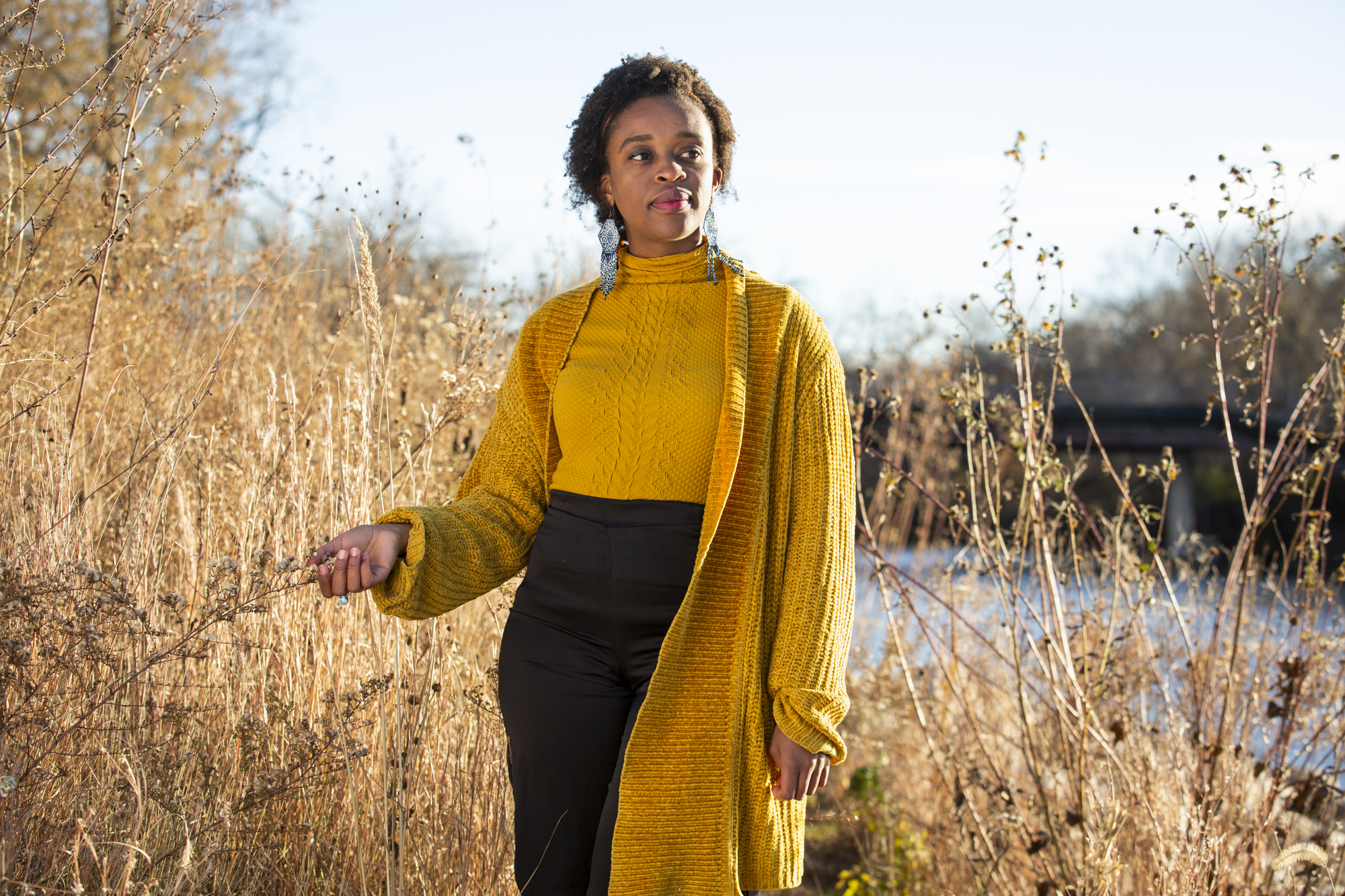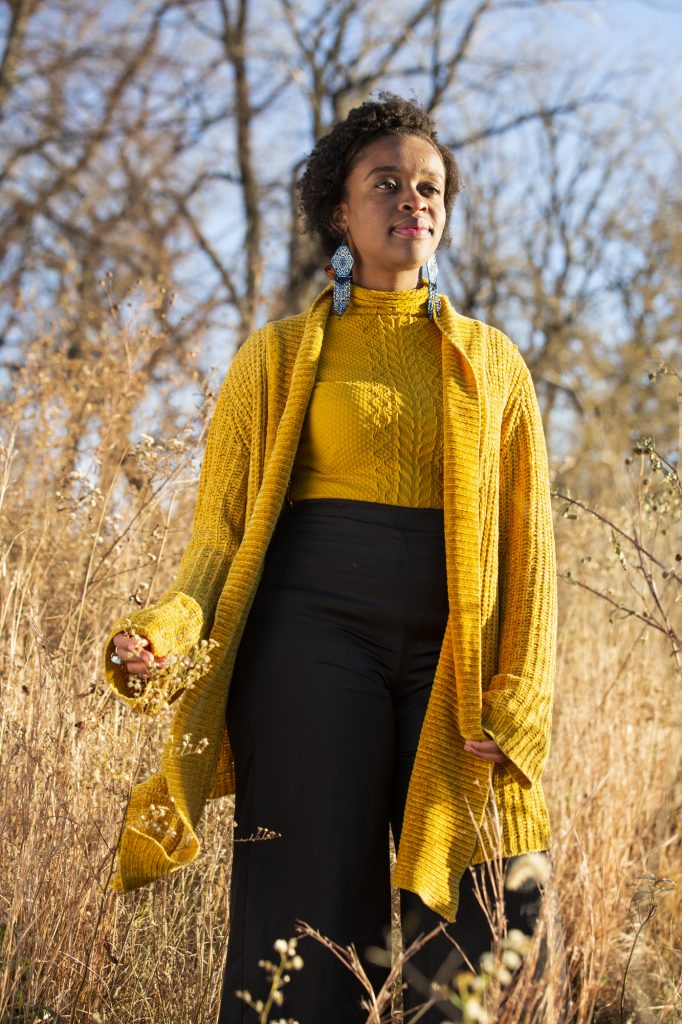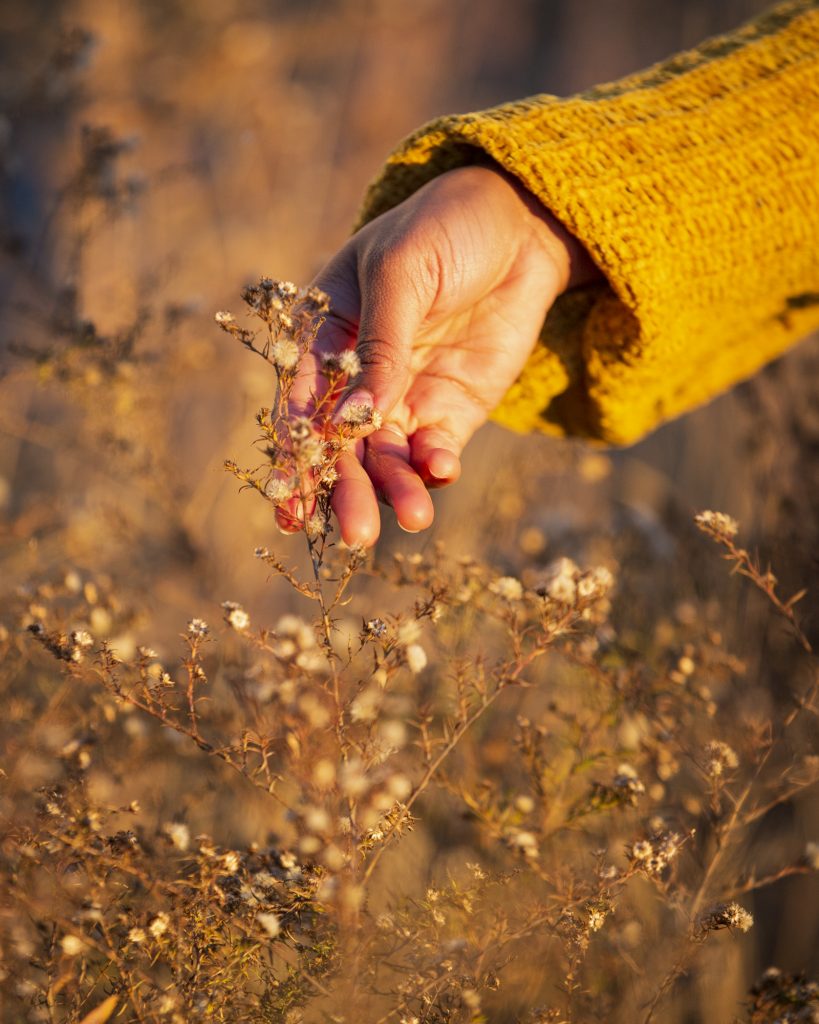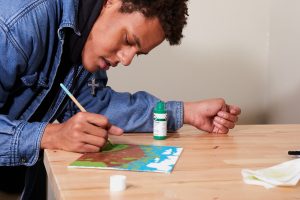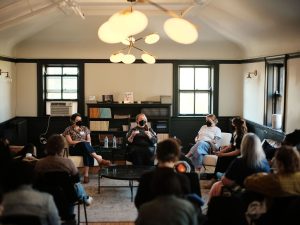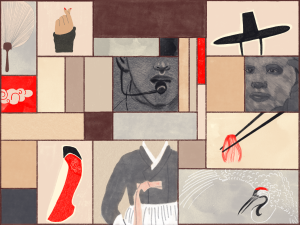Featured image: Abena Motaboli stands in a wheat field wearing a yellow sweater and black pants. She has one hand up touching the wheat while looking slightly towards the right. Photo by Kristie Kahns.
Prairie Grass
by Abena Motaboli
Wild peaked prairie grass;
Your skin is so beautiful,
Your blades so slender,
Your dryness so sharp,
And yet
So tender.
Your breath,
So soft,
So fair,
So even,
With a warmth that deceives through this cold.
Prairie grass thank you.
For being here,
To grace these cold skies,
To warm my heart up,
And to wrinkle the lines around my eyes,
Through these winter months
* * *
As a poet, I am often asked what inspires my work, where I started, and what the process is when I create. These questions gave me the opportunity to reflect on my own writing process and made me extremely curious about that of other writers. The Evolution of a Thought walks through the minds of poets, exploring the origin and path of their work in order to gain insight into the myriad ways in which they create.
In the first installment of The Evolution of a Thought, I spoke with Chicago-based artist, poet, educator, and cultural worker Abena Motaboli. Originally from Lesotho, her poetry is rooted in her love of nature—a deep connection she first felt in the lush landscape of her home country. She is strongly influenced by the diversity of people, memories, and displacement, as well as ideas of human resilience seen through immigration. Through her written prose and poetry work, she explores these themes and uses them as a base for her sound and visual installations.
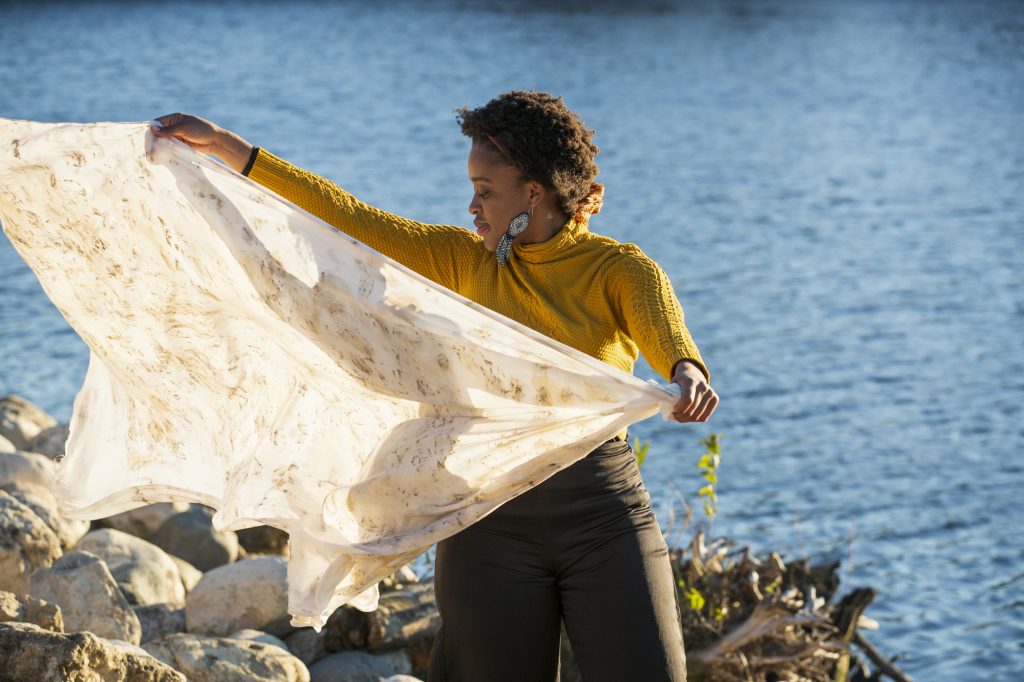
Kyra Horton: What got you into poetry?
Abena Motaboli: I’ve been writing for as long as I can remember. Like many other children, I grew up loving the imaginative wonders of being engrossed in a book—it was like finding a moment to escape into another world, even if only for a moment. It felt like a way to connect to different stories and histories that could now become a part of mine, reading books my mother and parents had read long before me and being able to talk about them. From that young age I loved writing stories, all of which we lost when we immigrated to the U.S from Lesotho in 2012.
I don’t remember when I transitioned from writing stories to writing poetry, but I do remember countless summer vacations in South Africa, seeing this beautiful mountainous scenery and thinking about how poetic and beautiful our landscape was and how I could translate these fleeting moments into writing.
Through this pandemic and before, I keep finding myself returning to writing the way a child would to a mother in times of love, doubt, sadness, happiness, and wonder. It’s an art form that helps me express what I can’t express and it helps me connect to myself and the living world around me.
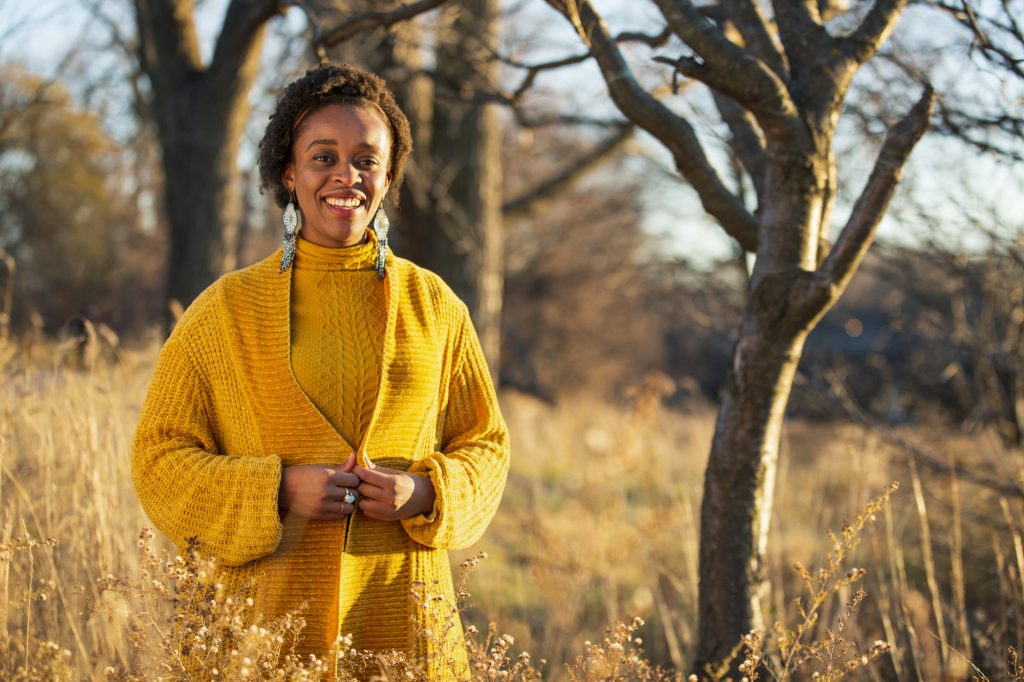
KH: How do you start a poem? When do you know you need to write?
AM: Writing a poem for me is like the feeling I get when I crave sugar or my favorite dessert. It sounds poetic but it really does feel like an innate need to write down everything I am feeling in that moment—like an urgency to communicate with myself.
Most of the time, I give myself space to feel and recognize what I am feeling, or if I am feeling uninspired, I return to the lake or go on a walk and observe what is happening with the plants until I am inspired again. It doesn’t take much; I’ve been learning a lot from simple observation and a love of plants—they’re all around us, waiting to show us their gifts.
Writing has also always been there for me to express my utter excitement and gratitude for the beauty of a sunrise, a clear blue sky, being alive, or as a way for me to process why I woke up in a mood.
KH: What inspires you most when you write (emotions, places, people. etc.)? Does this same inspiration feed into your visual art?
AM: I feel very connected to land. I grew up in Lesotho, a country landlocked by South Africa, and for the first 18 years of my life I was surrounded by mountains and a beautiful environment. My grandmother, who lived to over 104 years, lived in the quiet of a small village, where each time we would visit I would look at the stars with my feet on the ground and feel a connection to the land much deeper than myself. I still feel this connection whenever I am out in nature and that is eternally inspiring to me.
I recently wrapped up a six week residency with the Weaving Mill, where I had the chance to use their dye garden, which had a beautiful array of flowers and cotton, Japanese indigo, Marigolds, Coreopsis, and more. Over the course of six weeks I would find myself listening, learning, and sitting with the plants, using plant poetry to learn more about them and express my feelings to them or my gratitude for their being.
I am currently writing and illustrating a plant gratitude publication, which I hope to release in the Spring of next year. In a nutshell, I find a lot of inspiration in the living world around us—in the plants, tea, the land, dirt, the lake—and this always weaves its way into my visual arts practice.
KH: How do your different disciplines influence one another?
AM: What binds all of my work together is my love of our earth. I am interested in water, plants, trees, flowers, soil, creatures, and the living world around us.
I find wonder in giving myself ample space to use whatever feels right in that moment, so I don’t limit myself with materials. It feels organic and it keeps my art practice refreshing, like a world I can keep returning and returning to. In this way, my art practice weaves its way through everything that I do.
In my paintings I use tea, dirt, coffee, natural inks, and ephemeral material to comment on colonialism and the western world’s influence on developing countries like my own through things like tea, which came to my country through colonialism. It feels like being able to read history through the plants.
My installations, which use large tarps or torn plastics that have been with me for around 10 years, comment on the idea of being an immigrant and the endless search for home, recreating home wherever I go. These installations usually include soil or dirt as a way for me to explore memory and the idea of home.
In my practice as an educator, I am interested in creating more sustainable art practices—and I know there is complexity with the word sustainable. I am by no means 100% sustainable; I am learning about sustainability in the arts and teaching different age groups how to reconnect to nature and see its living beauty in order to create more sustainable interactions and artwork with nature—and also leaving an openness for learning, as we are all learning.
I’ve been thinking a lot about soil and my connection to land as a way to ground myself wherever I go; the soil was the first thing my feet touched as a young one, it is here with me now, and will be there when I return to the earth. I have been finding ways to connect to soil by interacting and writing poems to them and the plants that flourish in its body.
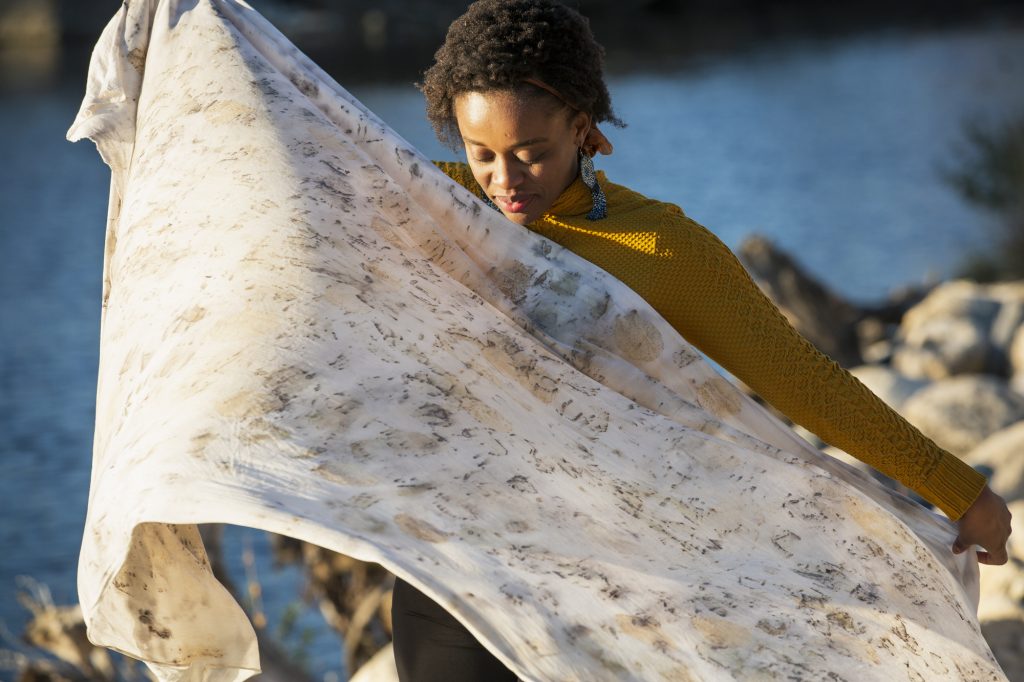
KH: What keeps you writing poetry? What does it do for you?
AM: Poetry is an incredibly intimate and integral part of the way I process in my visual arts practice. It has taken years for me to feel comfortable sharing my written work and poems, but I finally feel like it’s the right time to share.
Having a journal has always been integral to me. When the pandemic hit, like many others, I stopped creating any work because I was so anxious. But through all of those feelings I kept returning to writing by the lake—writing as a way of processing, as a way of letting go, as a way of finding myself again. I would go out to the lake where I feel most at ease or on a walk observing a dandelion or the leaves on a tree and write about them, to them, or a poem for them.
I’ve been working on a series of poems about and to the lake every time I go, which is a lot. I write a letter to the water, sometimes about observing the way the water moves, other times it is a love letter to our mother earth through the waves. Some days I write to the water as a way for me to process my thoughts of the day. I write a lot, as a way of processing the world around me, as a practice of gratitude, letting out all of my feelings, or simply as a way to start a piece of art.
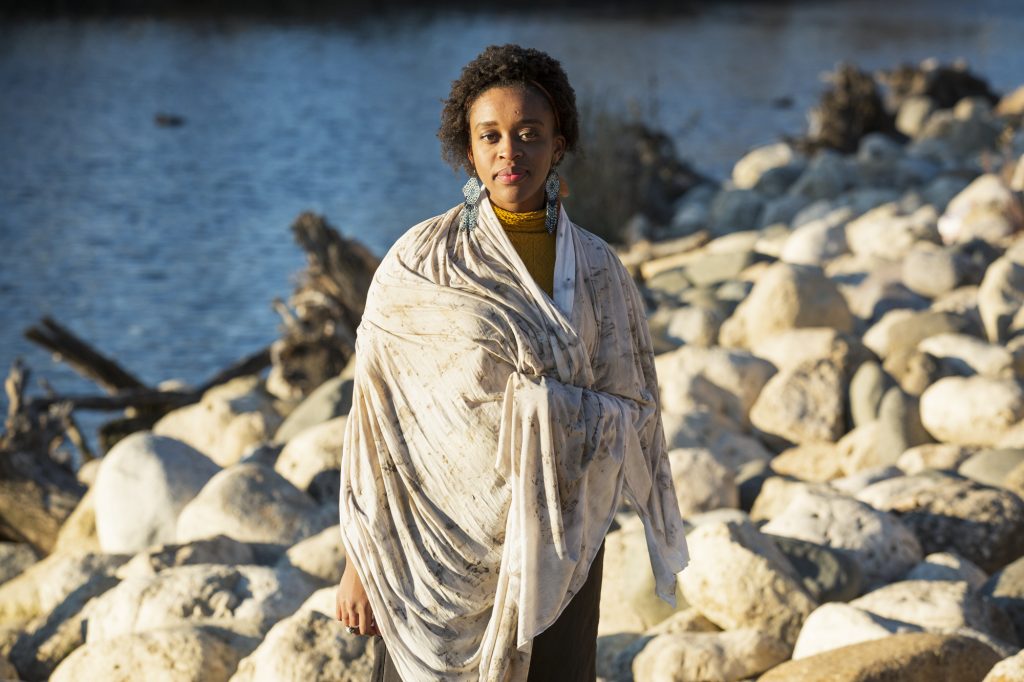
KH: What emotion shows up most in your poetry? How does your poem go from that emotion to a well thought out concept?
AM: I go through a lot of emotions with my poetry. It depends on the day and what mood I am in. Some days I write from a place of sadness, or anger, or love, and it comes out in my writing usually in the form of wonder and hope and recognizing the histories being told all around me.
I mostly think about my own connection to the things around me and whatever I am feeling, which is usually gratitude or a need to learn more and be more curious about the histories that the trees around us hold, the grounds I walk on, the air that I breathe, or the plant knowledge all around me.
I love learning and consider myself very curious, so I like to explore this emotion through the beauty of this place we belong, as well as nature, the elements, and the curiosity with which we must live in order to have a deeper understanding or reciprocal relationships with our environment.
KH: Do you typically finish a poem in one sitting? If not, is it hard to go back to it?
AM: I always carry around one of my numerous journals, I have small hand-made ones made with recycled paper and brown paper bags, I have larger ones where I journal, I have sketchbooks where I write in between my drawings, and other journals with my stream of consciousness thoughts. If I don’t have a journal on me I usually record a voice note, which then becomes a sound piece, or another form of poetry.
I usually start off in a very stream of consciousness way, and then the piece takes shape into either a longer prose-like format or a shorter poem. Most of them come from a place of wonder, marveling at the beauty of our earth, being with the water, observing a plant in bloom, or the beauty of a dry blade of grass.
I let myself express whatever I am feeling or whatever comes up to me in that moment in the form of writing, and then it’s done. There’s almost an intensity to get a thought out.
I don’t usually go back to a poem once it’s done. I am a very present, in the moment person and I feel everything, including overwhelming doses of gratitude, which I hope to capture through a written piece—it feels raw and honest to my inner emotions. Editing and going back to poems is challenging, especially if I am in a different headspace. When I do revisit poems, they turn into completely new poems. If I do have to rewrite them for a publication, it feels harder to reconnect to them—it’s almost like reconnecting to distant feelings.
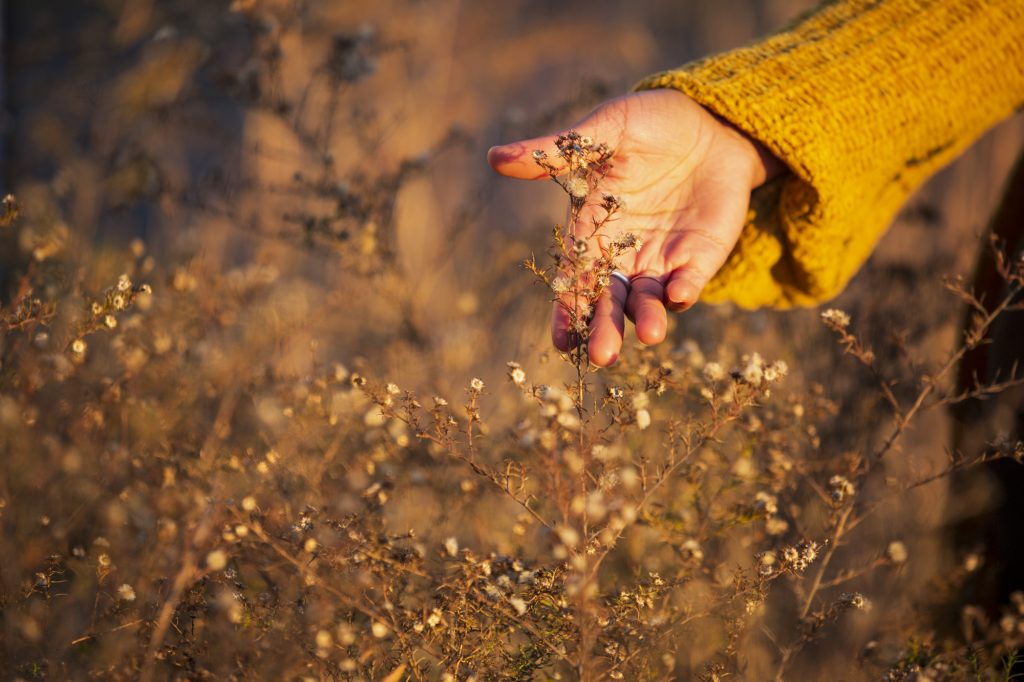
KH: What’s the most challenging part about writing?
AM: There are many things I could say are challenging: time, not feeling inspired, or not liking some pieces. But one of the bigger challenges has been the feeling of imposter syndrome, which is a concept I absolutely dislike. I never really considered myself a poet, but I love writing poetry and stories. Because it is such an intimate art form, it has taken me years to feel comfortable sharing my writing and as of late it has felt really good to just share this part of myself.
Something that has also been challenging about writing is that it’s a process; a lot of my work does not feel finished to me, it’s a continuation of many, many thoughts. Writing has taught me that so much of our journey is this process, a process of recognizing myself, a process of really seeing and deeply listening to our lived environment and all the plants that live here, too, and, of course, a process of growth. Similar to all the pieces that I have written that have helped me think things through, it’s a journey about transformation and acknowledging that we are constantly changing beings on this planet and that that is beautiful.
KH: If you could give advice to someone wanting to start writing poetry, what would it be?
AM: Bring a little journal with you wherever you go. The times I am most inspired I am usually out in nature and there is something so special about having a little piece of paper and a pen in your pocket to put down some of your thoughts or stories and connect to a plant or water.
Sometimes I have so much gratitude for the power of nature while on a walk, and I find that when I have my little handmade journal in my back pocket I have no excuse other than to write. It’s quicker than drawing or painting, which I love, but similar to a sound recording, it makes it easy to capture a moment. If I have only my phone on me, I’ll usually record a voice note and use it as inspiration for a sound piece or I’ll come back with a written piece or poem later that same day when I have paper.
I’d also encourage people to journal—make it a practice, make it a habit. It’s been very therapeutic for me to wake up with meditation, have a cup of tea, and just free write or journal. It helps me check in with myself and also sparks creativity for days I wake up feeling uninspired or overwhelmed, or in awe of the world. Free writing is also a great activity to do with a group of friends, it makes the pressure to write an amazing piece of writing totally disappear.
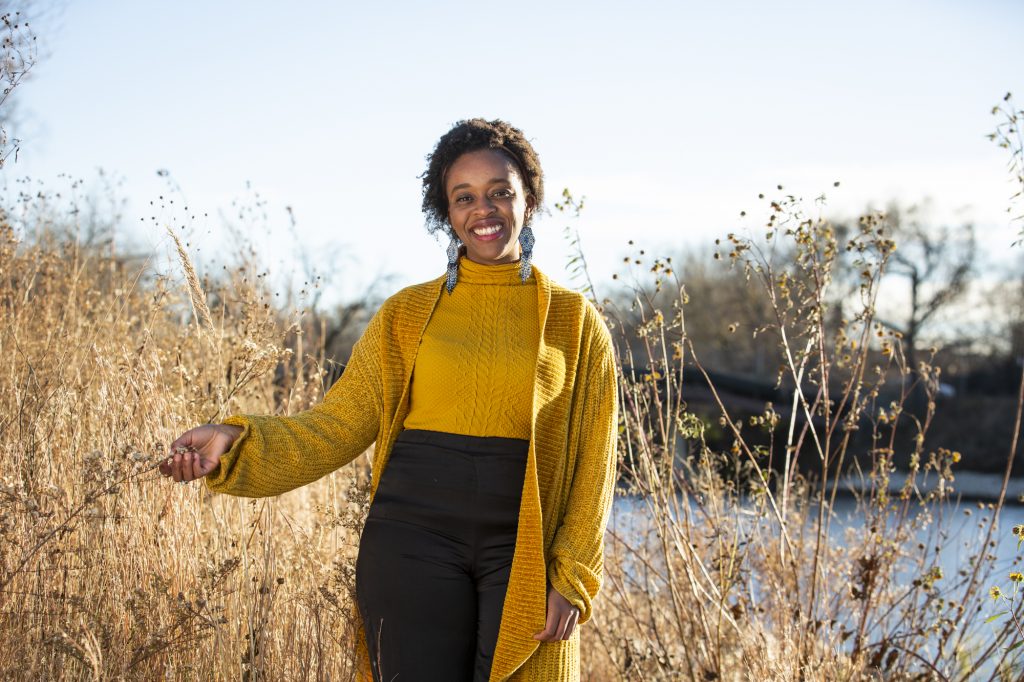
KH: Much of your poetry (as well as your visual art) references nature. Can you talk about your connection to nature and its role in your creative practice?
AM: I feel very connected to nature, as I grew up in a small country surrounded by mountains. I didn’t realize what a privilege I had growing up in Africa; a continent where people have access to connecting to land. It was a privilege I felt was taken away when my family and I moved to the U.S. I had never had to think about land in terms of ownership and restricted access to nature until we moved here, or the idea that someone or the government owns dirt—which should be free and as accessible as the air. These thoughts have prompted me to explore soil and natural pigments with my visual practice. I’ve been craving the feeling of putting my feet in the dirt of my hometown, or having someone send some over to me to make pigments or an art piece with.
Over the past few years I’ve been learning more about Indigenous land practices and Indigenous peoples in this country and I feel a strong connection to the importance of reciprocal relationships with the earth and all its living beings. This is how my ancestors in Southern Africa and West Africa have lived for centuries.
Lately, I’ve been thinking about the practices of my relatives in Lesotho and Ghana and I see the love of this place we call home; our connection to water, land, animals, and plants. I try to share this through my educator practice with youth through the Chicago Park District, youth at Marwen, and senior citizens through the Garfield Park Conservatory Alliance.
I think back to my childhood and I remember being in the garden in the summer, learning about plants from my mother, or having a summer vacation in South Africa with my family and camping in Pilanesberg National park, surrounded by vast skies and beautiful nature that was accessible or free for the population there. I think back to all the times we visited my grandmother in a little village in our mountain town in Lesotho, I think of my connection to my ancestors as well as my living grandmother in Ghana, and I have so much gratitude for our connection to our lands and our ancestors. This is something I channel through my work in my creative practice here, and it’s a gift that has taught me so much about why we have to learn about our environment and be in touch with both nature and the plants around us.
All of these sentiments lead me to create this deep connection to nature, which is in all of us. And it gives me joy to share this through my gratitude poems to the soils, the water, our mother earth, the natural pigments I make and paint with, the sound pieces , installations referencing our earth, or a piece of nature-inspired writing.
They all come out of a sense of urgency that we need to connect, understand, and take care of our lived environment.
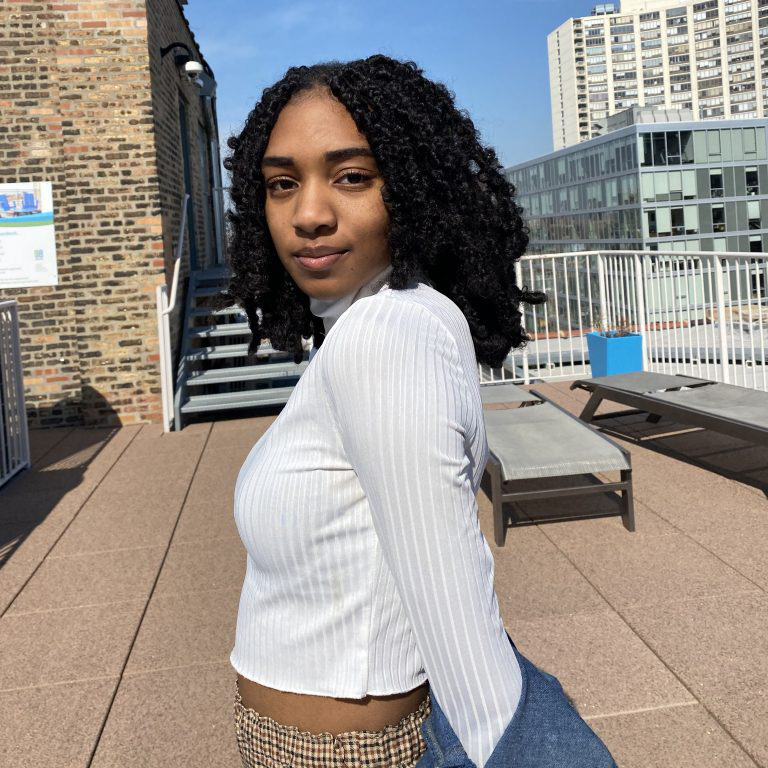
Kyra Horton is a 20 year old creator raised in Chicago. Whether expressing herself through writing, performing, or painting, she strives to turn pain into beauty. As a Black woman, she aims to capture life’s complexities through her art while still remaining genuine to who she is. She is fearless on her journey expressing the emotion painted in her heart. The world is her canvas, while also being her muse.
